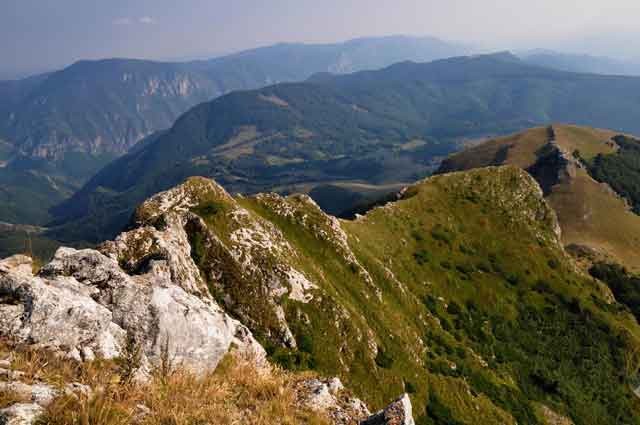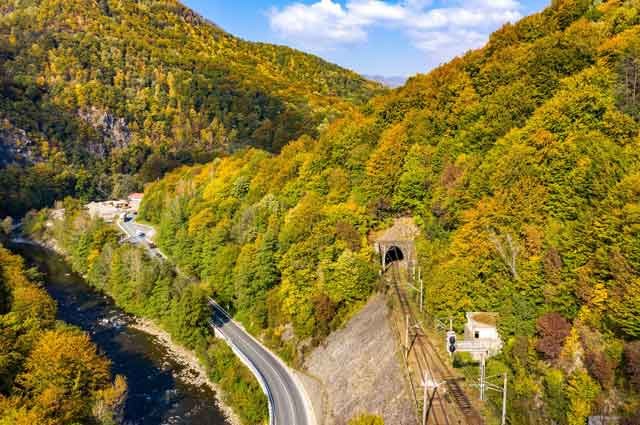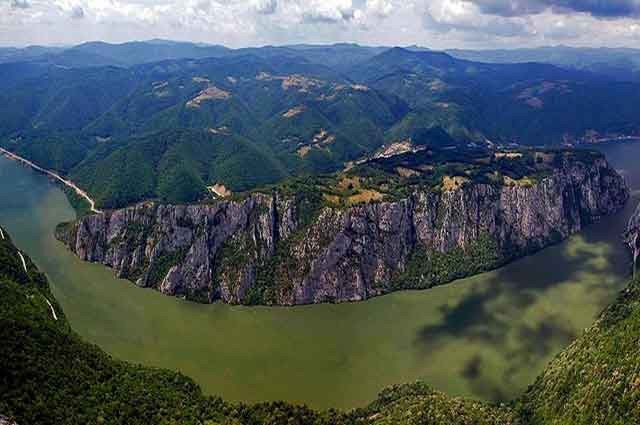Nature and Animals of Romania. Nature Parks from Oltenia.
I will tell you some important things about Romania’s flora and fauna. Nowadays, one-third of Romania's territory is a mountain area, largely forested, where most of the interesting flora and fauna are to be found. Another third of the country territory is hills and plateaux areas, with a fair quantity of woodland still remaining, and another third is a plain area, most intensively farmed.
Highlights
National Park Domogled-Cerna

The National Park is situated in the southwest part of Romania and covers three counties: Caras-Severin, 23.185 hectares; Mehedinti - 8.220 hectares and Gorj - 29.806 hectares. The diversity of landscapes, unique thermal caves, thermo-mineral springs, as well as the endemic and rare flora and fauna offer a unique and special trip for all visitors. Experiencing the park will take you through many landscapes, including calcareous slopes with the Black Pine of Banat, canyons carved by streams, calcareous peaks with sub-Mediterranean vegetation, vast beech forests, high alpine meadows, mountain reservoirs, and calcareous gorges and precipices.
Established in 1990, the Domogled Cerna - Valley National Park has been administrated since 2003. The Domogled-Cerna Valley National Park has a remarkable floristic diversity, in part due to it`s complex physical-geographic, climatic, and abiotic conditions.
The park flora includes 110 species of vascular plants. The excellent biodiversity of the flora has attracted foreign botanists since the end of the 18 century (Griselini 1780). Of the total unplaned plants (1110 species), 66 types are endangered or rare, while others are very localized. This means they are rare or unknown species in other parts of the country. Examples of this are Vicia truncatula, Tragopogon balcanicus, Cerastium banaticum, Lamium bithynicum. Due to biogeography, biological, and climatic conditions, the national park preserves a very interesting and rich fauna.
The park fauna has numerous scientifically valuable species. Some are unique in the country and worldwide; the park especially excels in the diversity of insects. The national park is characterized by high biodiversity regarding the butterfly fauna. More than 1500 species are concentrated here, including 45% of Romania’s Lepidoptera species. A large number of butterfly species are endemic, such as Lampronia aeripenella, Brevantenia banatica, Eupithecia domogledana, Melicta athalia mehadiensis. Presently, the studied invertebrates have included some very rare species, emphasizing the park`s importance.
From among the vertebrates, the birds have been studied best. Still, the results and data are incomplete. The bird fauna is diverse and rich. As an outcome of the research regarding the bird species, the following facts were established: species with meridional origin are present (Mediterranean and Indo-African), the forest avifauna has a specific character, being distinguished among the general characteristic of the Carpathian ornithological fauna, the lower limit of the mountainous species habitat has values less than those recorded in the Carpathian mountains.
The following are strictly protected species of birds in the park: Apus melba, Coracius garrulus, Cinclus cinclus, Oenanthe hispanica, Emberiza citrinella, etc.
The reptiles within the national park can be found both in the alpine and nemoral areas, the latter containing more species. Among these exist protected and endemic species, such as Vipera ammodytes, Testudo hermanni, Lacerta vivipara, L.muralis,Natrix tessellato, Vipera berus, etc.
The amphibians inside the natural protected area are represented by the following species: Triturus alpestris alpestris, Bombina variegata, Salamandra salamandra, Bombina bombina, Rana dalmatina.
For the aquatic vertebrates, the park is home to these species: Salmo trutta fario, Thymallus thymallus, Barbus barbus. Wild mammals have their habitat deep in the forests, mostly in the Cerna basin.
This area is characterized by great richness of important mammals within Europe, such as Ursus arctos, Lynx lynx, Rupicapra rupicapra, etc. Bat guano is common in one of the national park’s thermal caves - Adam’s cave. Here we can find the thickest accumulation of bat guano of all Romanian caves (3m. thick, accumulated from different bat species but primarily from Rhinlophus euryale).
The geographic, climatic and habitat conditions in the Domogled-Valea Cernei National Park have made possible the existence of a diverse and large amount of fauna. The karstic relief within the Domogled-Valea Cernei National has an unequal distribution due to the unequal spreading of the limestone. Therefore, these characteristics are among the main highlights of the national park. The caves located in Cerna’s upper basin are of small sizes (rarely more than 100 m in total length), with one entrance, low amounts of mineral deposits, and generally are hard to access. These caves don’t represent a great tourist attraction.
On the whole surface of the national park, there are more than 300 caves, in addition to some cavities, which can’t be called caves due to their small size. The thermal caves within the national park, in Cerna Mountain, are unique and rare in Romania and the rest of the world. The environmental conditions inside the caves are similar to a tropical climate (35-45C air temperature). Due to this fact the fauna, stalactites, and stalagmites have a unique character. An example is Adam’s cave, which could be declared a scientific reserve for the conservation and study of unique tropical oasis conditions in Romania, for warm air spaces, bat colonies, and jellied stalactites. Another interesting thermal cave is the „Steam Grotto” (14 m in length), in which hot, sulfurous steam (52 - 56 C) comes to the surface from below ground, through a break in a rock. The sounds created by the sulfurous emissions pull our imagination into a complex and curious world. These conditions are satisfactory for a species of moss - Philonotis schliephackei - which can be found only here. The gypsum crusts are also very rare in the park’s caves. These are stalactites and stalagmites on large surfaces, which can be found in the park’s Ion Barzoni cave.
In Mehedinti Mountains are the most beautiful visual relief in the park. The endokarst in this area, or caves containing little mineral deposits, represent a comparatively small land area. The exception is „Pestera mare de la Soroniste”, in which impressive stalagmitic pillars can be found. Other caves in this area that can be visited are: „Pestera de sub Sarban” and „Gaura Ungurului”, which are important due to calcitic stalactites/stalagmites and bat colony.



Jiu River Gorges

The National Park The Jiu Gorges was born in 2005 and extends to 11.000 hectares The park runs along the gorge of river Jiu between the massifs Parang and Valcan being crossed by the European Road 79 (E 79).
This area is covered by forests about 85%, the rest being meadows. The compact forests, many of them new, have trees like beech, oak, and hornbeam. The diversity of the species offers a distinct note to the biodiversity of the park.
We can mention some of the species of the fauna from the park: viper, brown bear, wolf, lynx, otter, marten, badger, and wild cat The herbivorous species are represented by the deer, stag, and chamois.
The National Park has also species of Bats and birds like the pigeon hawk, peregrine falcon, common buzzard, golden eagle, and ouzel. Aquatic environments offer living conditions for triton species and for the frogs.



IRON GATES - NATURE PARK

The Natural Park around the Iron Gates is situated in the south-west of Romania on the state frontier with Serbia having a surface of 115 - 655 hectares, (285 - 900 acres) The Flora of the park contains eastern elements, together with panonic and Mediterranean.
The distinctive color of vegetation is formed from plant species as garn, wild lilac, Turkish hazel. There are also, elements such as mountain beech (Fagus sylvatica), yew (Taxus baccata), bilberry (Vaccinium myrtillus) where it drops in elevation Danube Gorge. Iron Gates Natural Park vegetation consists mainly of forests, shrubs, and meadows, their distribution is conditioned on the particular substrate. Forests cover about 70-75% of the park and are entirely (deciduous) The main types of forest are beech, beech mixed with oak, hornbeam with thermophilic oak.
The Fauna of the Iron Gates Nature Park includes 4.873 species of invertebrates with some special species like Scorpio (Euscorpius Carpathians) Scolopendra (Scolopendra cingulata) and 332 vertebrates. Among vertebrates, the class of Aves is important with 205 representatives, followed by Class Pisces - 63 representatives, the most poorly represented by 12 being Amphibia. The salamander, triton, and water snake are also well represented. As mammals, we can include, bears, badgers, wolves, foxes, lynx, wild boars, marten, and deer. The present situation composing wetlands and bird fauna park is due to the creation of the Iron Gates Dam I, which led to the emergence of new wetland habitats for waterfowl and waders: pygmy cormorant, cormorant, grey heron, little egret, great egret, little misrate caraitoare, rate spearmen, Northern Shoveller, brown-headed duck, Tufted duck, small Coot.
The turtle of Hermann known as turtle dry is an elusive herbivorous reptile. It is a strictly protected species in danger of extinction due to the decreasing populations and habitat. It has an oval shell-covered body, domed; yellowish to olive green. It is composed of two parts: the actual shell (dorsal) and stiffening panels (ventral). The Hermann’s Turtle habitats are found all over the Balkan peninsula and the Italic peninsula. They occupy a trough located in the southwest of the country between Livingston and Bazias, living in grasslands and meadows close to the edges of the forest, where bushes grow in which they hide during the day. Hermann’s tortoise is a solitary species, which in late October burrows into the ground to depths of over 15 cm and enters a hibernation period until March. They mate in spring, and during May and June, the female digs a pit in a sloping area laying 6-7 eggs. The eggs sit in the ground for about 2 months, then hatch out alone, without help from the mother. At this stage, they are vulnerable to nest predators: martens, foxes, hedgehogs, etc. As a result, the survival rate is very low, on average only one out of six survives. Males are smaller than females, have longer tails, and possess strong claws. The age of turtles can be deduced from the number of rings that form on the plates of the shell surface. Turtles can reach ages of over 60 years. Hermann’s tortoise is a peaceful animal, loved by locals, according to tradition, bringing good luck to those it meets. The main threats are hunting by tourists or locals for various reasons, their collection for sale as pets or in restaurants. These activities are illegal and are punished by the law with fines.
The climate type of the National Park is temperate - continental with important influences from the mediterranean sea. Because of this influence of the Mediterranean air, the climate in the Danube Gorges is close to the Mediterranean one. Iron Gate reservoir is the largest hydro system along the Danube in Romania, situated behind the dam at the Gura Valley, which has a height of 60.6m; the lake has a length of 130 km, an area of 700 square kilometers, and an average of 12 km. Construction of Hydropower and Navigation System Iron Gates Dam caused the displacement of settlements (Orsova Svinita, Eselnita) and the disappearance of others (Tisovita, Ogradena, Plavisevita, Ada - Kaleh), ancient hearths being flooded by lake waters of Iron Gates I. Nowadays Iron Gate reservoir is used for power generation, regulation of the Danube flows, fisheries, navigation, and recreation is also favorite habitat for many species of aquatic birds.



